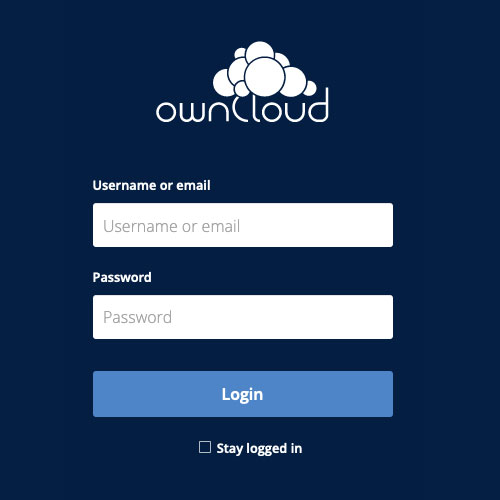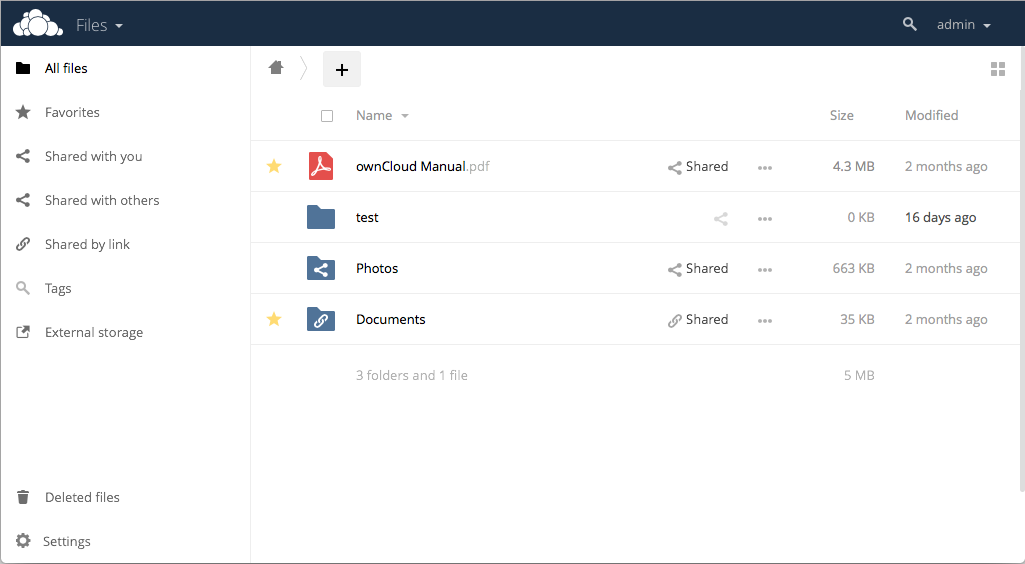The Web Interface
Introduction
You can connect to your ownCloud server using any Web browser; just point it to your ownCloud server and enter your username and password. Supported Web browsers are:
-
Edge (current version on Windows 10)
-
IE11 or newer (except Compatibility Mode)
-
Firefox 60 ESR or newer
-
Chrome 66 or newer
-
Safari 10 or newer

Some apps like files_external or encryption will disable the Stay logged in checkbox.
|
Navigating the Main User Interface
By default, the ownCloud Web interface opens to your Files page. You can add, remove, share files and make changes based on the access privileges set by you (if you are administering the server) or by your server administrator.

| The file size values differ depending on the client you are using. Some operating systems like iOS and macOS use the decimal system (power of 10) where 1kB or one kilobyte consists of 1000 bytes, while Linux, Android and Windows use the binary system (power of 2) where 1KB consists of 1024 bytes and is called a kibibyte. So no reason to worry if you see different file sizes in ownCloud Web and your mobile device. |
The ownCloud user interface contains the following fields and functions:
-
Apps Selection Menu: Located in the upper left corner, click the arrow to open a dropdown menu to navigate to your various available apps.
-
Apps Information Field: Located in the left sidebar, this provides filters and tasks associated with your selected app. For example, when you are using the Files apps you have a special set of filters for quickly finding your files, such as files that have been shared with you, and files that you have shared with others. You’ll see different items for other apps.
-
Application View: The main central field in the ownCloud user interface. This field displays the contents or user features of your selected app.
-
Navigation Bar: Located over the main viewing window (the Application View), this bar provides a type of breadcrumbs navigation that enables you to migrate to higher levels of the folder hierarchy up to the root level (home).
-
New Button: Located in the Navigation Bar, the New button enables you to create new files, new folders, or upload files.
| You can also drag and drop files from your file manager into the ownCloud Files Application View to upload them to ownCloud. Currently, the only Web browsers that support drag-and-drop folders are Chrome and Chromium. |
-
Search Field: Click on the magnifier in the upper right-hand corner of to search for files.
-
Personal Settings Menu: Click on your ownCloud username, located to the right of the Search field, to open your Personal Settings dropdown menu. Your Personal page provides the following settings and features:
-
Links to download desktop and mobile apps
-
Re-run the First Run Wizard
-
Server usage and space availability
-
Password management
-
Name, email, and profile picture settings
-
Manage connected browsers and devices
-
Group memberships
-
Interface language settings
-
Manage notifications
-
Federated Cloud ID
-
Social media sharing buttons
-
SSL certificate manager
-
ownCloud Version information
-
See userpreferences section to learn more about these settings.